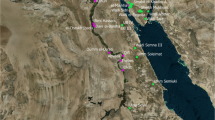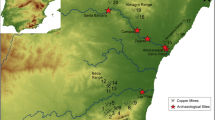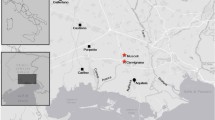Abstract
Copper isotopes can be successfully used to determine the origin of copper or bronze artefacts from either primary or supergene sulphide or hydrocarbonate ores. In conjunction with lead isotopes, they provide information on the origin and type of the metal ore. We demonstrate this in this paper from the combination of literature and own data on metal ores and artefacts (coins and ingots). Low-temperature hydrocarbonates (esp. malachite and azurite) do not fractionate the copper isotopes amongst each other and have identical lead isotopes. Substantial fractionation of copper isotopes, however, occurs between copper sulphides and hydrocarbonates (malachite, azurite) such that the 65Cu isotope is always enriched in the oxidised relative to the sulphide phase with a clear distinction between the two ore types. Expressed in the δ65Cu notation, we assigned supergene sulphides to values less than −0.4‰ down to negative values of −2‰ and more, primary sulphides to a range between −0.4 and +0.3‰ and hydrocarbonates to positive values higher than +0.3‰. We have applied these boundaries to copper coins and ingots from the time of the Roman emperors with known ages from Augustus up to 250 AD. The deposit fields of the metal used for the production of the coins were previously identified from the lead isotope ratios to lie in the Southwest and the Central South of Spain. From the combination of the lead and copper isotopes and the exact time constrains, we could develop a picture of the change in mining activities in Spain involving continued mining sulphide ore deposits and, indicated by positive δ65Cu values as proxies for malachite and azurite, the opening of new mines in various time slots. This first application shows that copper isotopes will become the most important tool in archaeometallurgy to distinguish between the exploitation of deeper-seated primary and supergene sulphide ores and shallower, secondary hydrocarbonate ores. This will become especially relevant for archaeometric questions regarding the distinction between occasional and intentionally produced alloys.









Similar content being viewed by others
References
Artioli G, Baumgarten B, Marelli M, Giussani B, Recchia S, Nimis P, Giunti I, Angelini I, Omenetto P (2008) Chemical and isotopic tracers in Alpine copper deposits: geochemical links between mines and metal. GeoAlp 5:139–148, Bozen, Innsbruck
Asael D, Matthews A, Bar-Matthews M, Halicz L (2007) Copper isotope fractionation in sedimentary copper mineralization (Timna Valley, Israel). Chem Geol 243(3–4):238–254
Colpani F, Marelli M, Giussani B, Recchia S, Angelini I, Baumgarten B, Artioli G (2007) Copper isotopic ratio and trace elements spectrometric measurements (ICP-QMS) within Alps and Apennine Cu-ores: discovering regional geochemical tracers for archaeometrical purposes by advanced chemiometric techniques. In: D’Amico C (ed) Atti IV Congresso Nazionale di Archeometria, Pisa, 1–3 Febbraio 2006. Pàtron Editore, Bologna, pp 547–559
Domergue C (1987) Catalogue des mines et des fonderies antiques de la Péninsule Ibérique. Tome I and II, 585 p. + attachements. Publications de la Casa de Velázquez, Série Archaéologie VIII, Madrid
Domergue C (1990) Les mines de la Péninsule Ibérique dans l'antiquité romaine. 626 p., Collection de l’Ecole Française de Rome, 127, XX
Durali-Müller S (2005) Roman lead and copper mining in Germany—their origin and development through time, deduced from lead and copper isotope provenance studies. Available at: http://www.mineralogie.uni-frankfurt.de/petrologie-geochemie/forschung/dissertationen/diss0106/index.html
Ehrlich S, Butler I, Halicz L, Rickard D, Oldroyd A, Matthews A (2004) Experimental study of the copper isotope fractionation between aqueous Cu(II) and covellite, Cu. Chem Geol 209(3–4):259–269
Ericson J, Shirahata H (1983) Lead isotope analysis of ancient copper and base Metal Ore deposits in Western India. In: England PA, Lambertus van Zelst Application of Science in Examination of Works of Art. Proceedings of the Seminar, Boston, Sept. 7–9, pp 207–212
Frimmel HE (1999) Sediment-hosted base metal sulphide deposits in Neoproterozoic strata of Namibia. Miner Deposita 1(34):273–283
Gale NH, Woodhead AP, Stos-Gale ZA, Walder A, Bowen I (1999) Natural variations detected in the isotopic composition of copper: possible applications to archaeology and geochemistry. Int J Mass Spectrom 184:1–9
Gulson BL (1979) A lead-isotope study of the Pb–Zn–Cu deposit at Woodlawn, New South Wales. Aust J Earth Sci 26(3–4):203–208
Klein S (2008) Das Kupfer der römischen Kaiserzeit und seine Rohstoffquellen. Professorial dissertation (Habilitation), Goethe-Universität Frankfurt, 53 p. + attachments
Klein S, von Kaenel H-M (2000) Metal analysis and numismatic studies of early Roman Imperial Bronze coinage. Part 1: chemical characterisation of copper coins from Augustus to Claudius. Rev Suisse Numis 79:53–106
Klein S, Lahaye Y, Brey GP, von Kaenel H-M (2002) Blei- und Kupferisotopenanalysen an Kupfermünzen der römischen Kaiserzeit. Beiheft zu European Journal of Mineralogy 14:84
Klein S, Lahaye Y, Brey GP, von Kaenel H-M (2004) The early Roman Imperial aes coinage II: Tracing the copper sources by lead- and copper-isotope analysis—copper coins of Augustus and Tiberius. Archaeometry 46(3):469–480
Klein S, Rico C, Lahaye Y, von Kaenel H-M, Domergue C, Brey GP (2007) Copper ingots from the western Mediterranean Sea: chemical characterisation and provenance studies through lead- and copper isotope analyses. J Roman Archaeol 20(1):202–221
Klein S, Domergue C, Lahaye Y, Brey GP, von Kaenel H-M (2009) The lead and copper isotopic composition of copper ores from the Sierra Morena (Spain)—Análisis de los isotopos de plomo y de cobre de los minerales de cobre de la Sierra Morena (Spain) por MC-ICP-MS. Journal of Iberian Geology 35(1):59–68
Krymsky R, Balyatsky B, Klindukhov V, Kapitonov I, Lazareva L (2006) Cu isotope systematics of the MAR hydrothermal fields. Geophys Res Abstr 8:08170
Larson PB, Ramos FC, Maher K, Gaspar M, Chang Z, Meinert LD, Wolff JA (2002) Cu Isotopes: tracing metal sources in ore deposits. Goldschmidt Conference Abstracts: A432
Larson PB, Maher K, Ramos FC, Chang Z, Gaspar M, Meinert LD (2003) Copper isotope ratios in magmatic and hydrothermal ore-forming environments. Chem Geol 201(3–4):337–350
Maréchal CN, Télouk Ph, Albarède F (1999) Precise analysis of copper and zinc isotopic compositions by plasma-source mass spectrometry. Chem Geol 156:251–273
Markl G, Lahaye Y, Schwinn G (2006) Copper isotopes as monitors of redox processes in hydrothermal mineralization. Geochim Cosmochim Acta 70:4215–4228
Rico Chr, Domergue C, Rauzier M, Klein S, Lahaye Y, Brey GP, von Kaenel H-M (2005–2006) La provenance des lingots de cuivre romains de Maguelone (Hérault, France). Étude archéologique et archéométrique. Rev Archéol Narbonn (RAN) 38-39:459–472
Rouxel O, Fouquet Y, Ludden JN (2004) Copper isotope systematics of the lucky strike, rainbow, and Logatchev sea-floor hydrothermal fields on the mid-Atlantic ridge. Econ Geol 99:585–600
Santos-Zalduegi JF, García de Madinabeitia S, Gil Ibarguchi JI (2004) A lead isotope database: the Los Pedroches–Alcuida Area (Spain); implications for archaeometallurgical connections across southwestern and southeastern Iberia. Archaeometry 46(4):625–634
Scott KM, Ashley PM, Lawie DC (2001) The geochemistry, mineralogy and maturity of gossans derived from volcanogenic Zn-Pb-Cu deposits of the eastern Lachlan Fold Belt, NSW, Australia. J Geochem Explor 72:169–191
Shields WR, Goldich SS, Gerner EL, Murphy TJ (1965) Natural variations in the abundance ratio and the atomic weight of copper. J Geophys Res 70(2):479–491
Snoek W, Plimer IR, Reeves S (1999) Application of Pb isotope geochemistry to the study of the corrosion products of archaeological artefacts to constrain provenance. J Geochem Explor 66(1–2):421–425
Stos-Gale Z, Gale NH (2009) Metal provenancing using isotopes and the Oxford archaeological lead isotope database (OXALID). Archaeol Anthropol Sci 1:195–213
Strahm Chr, Hauptmann A (2010) The metallurgical developmental phases in the Old World. In: Kienlin TK, Roberts BW (eds) Metals and societies. Studies in honour of Barbara S. Ottaway, Universitätsforschungen zur prähistorischen Archäologie, Bonn, Habelt (In press)
Walker EC, Cuttitta F, Senftle FE (1958) Some natural variations in the relative abundance of copper isotopes. Geochim Cosmochim Acta 15:183–194
Woodhead AP, Gale NH, Stos-Gale ZA (1999) An investigation into the fractionation of copper isotopes and its possible application to archaeometallurgy. In: Young S, Pollard AM, Budd P, Ixer RA (eds) Metals in antiquity. , Oxford, Archaeopress, BAR International Series;792:134–139
Zhu XK, O’Nions RK, Guo Y, Belshaw NS, Rickard D (2000) Determination of natural Cu-isotope variation by plasma-source mass spectrometry: implications for use as geochemical tracers. Chem Geol 163:139–149
Acknowledgements
This work was financially supported by the Deutsche Forschungsgemeinschaft DFG. The authors would like to thank A. Hauptmann for discussion and A.K. Neumann for help in the laboratory. The obstinacy of an unknown reviewer contributed very much to an improvement of the paper. This is gratefully acknowledged.
Author information
Authors and Affiliations
Corresponding author
Rights and permissions
About this article
Cite this article
Klein, S., Brey, G.P., Durali-Müller, S. et al. Characterisation of the raw metal sources used for the production of copper and copper-based objects with copper isotopes. Archaeol Anthropol Sci 2, 45–56 (2010). https://doi.org/10.1007/s12520-010-0027-y
Received:
Accepted:
Published:
Issue Date:
DOI: https://doi.org/10.1007/s12520-010-0027-y




